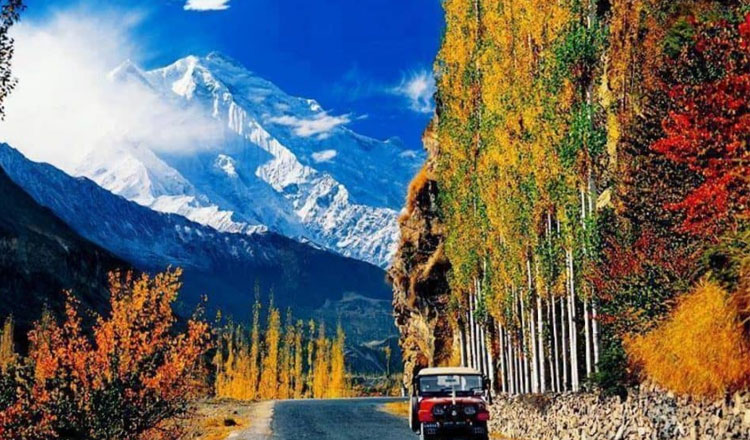Hunza is the most famous district of Gilgit-Baltistan among tourists. Hunza Valley is one of Pakistan’s most literate districts. The district’s capital is Karimabad. Hunza’s inhabitants are extremely fit and healthy. Good health is a result of the best weather conditions, pure cuisine, and tasty fruits. That is why the health of Hunzians is far superior to that of Gilgit-Baltistanis. Hunza’s population likewise has a greater average age than the rest of the country. We’ll tell you about the top ten locations to visit in Hunza, Gilgit-Baltistan, in this blog post, despite the fact that there are more than ten tourist-friendly locations to visit in Hunza. The following are the top ten places to visit in Hunza:
Attabad Lake Hunza
Attabad Lake is located in Hunza’s Shiskat Valley, about 30 minutes’ drive from Karimabad. Attabad Lake is so captivating that it will take your breath away. On Attabad Lake, tourists can go boating and jet skiing. In the Hunza Valley, Attabad Lake is a breathtaking sight. It is the Hunza Valley’s biggest attraction. In Hunza, Gilgit Baltistan, a huge earth slide catastrophe created Attabad Lake Hunza. Hunza Valley’s Attabad Lake is currently a popular tourist destination. This lake attracts visitors who enjoy boating.
Hussaini bridge
From one side to the other, six cables are hung. The wooden planks have massive gaps between them. In the gaps, several planks are missing. It is Pakistan’s most dangerous and highest suspension bridge. In northern Pakistan, the Hussaini suspension bridge spans the lake Borit, which is located upstream of the Hunza River. This bridge is also one of Pakistan’s oldest structures.
Altit Fort
According to oral history, Altit Fort Hunza is over 900 years old. On the bank of the Hunza River, about 3 kilometers from Karimabad, stands the Altit Fort. Karimabad is the Hunza Valley’s capital. The name Altit literally means “lower side.” This fort is composed of sturdy stones and wood, same like the other forts in Gilgit Baltistan. The Hunza River appears to be bowing in front of Fort from below. We can only imagine how hard-working the folks who built it were. The Altit Fort offers a breathtaking perspective of the Hunza Valley.
Baltit Fort
Hunza Valley’s Baltit Fort is a nearly 800-year-old fort. The Fort stands like a crown on the summit of the mountain, overlooking the valley. This fort’s antique but beautiful construction style is admirable. The palace of Hunza’s monarchs was the Baltit Fort, which was built on a firm foundation of strong stones and timber.
Passu Cones
The Passu Cones are a group of insinuated peaks in the Hunza Valley of the Karakoram Range. The Karakoram highway’s cone-shaped collection of mountains is breathtaking. Passu Cones and Passu Peaks are the names of the cones. These are in Pakistan’s northwestern Hunza Valley, in the Karakoram mountain range. The highest point is 6,106 meters above sea level. The different summits of Passu Cones have been climbed by a small number of persons. Climbing the summits will be a significant undertaking that will necessitate careful planning. Some of them are extremely steep and may necessitate a tricky ascent. This lovely spot attracts a large number of local and international tourists, especially during the summer months.
Shimshal Valley
Shimshal Valley is a mountainous valley in Hunza Valley’s Gojal. Nearly 3,100 meters above sea level, this valley. Shimshal is also a border settlement that connects Pakistan’s Gilgit-Baltistan region with China. Passu Village is roughly 55 kilometres from Shimshal. Most importantly, the valley is home to Hunza’s main adventure area and is a popular tourist destination. Shimshal is made up of four tiny villages. Aminabad, Farmanabad, Khizarabad, and Central Shimshal are their names.
Khunjarab Pass
Pakistan and China are separated by the Khunjarab Pass. The Pak-China Economic Corridor’s starting place. This Corridor will benefit both countries in a variety of ways. The Pak-China border is a must-see attraction for anybody visiting Gilgit Baltistan. It’s a good idea to bring a jacket because it’s cold and windy here. Yaks can be found nearby, and riding one is a fantastic experience. There is so much to say about this border and the magnificent views it provides that we will try to write another lengthy post about it.
Avgarch Valley
Avgarch is a historic Wakhi village in the Gojal Valley region. The historic structures are still standing and reveal a lot about past history. In this valley, there is no road access. Walking is the only way to get here. There’s plenty of open space, grazing animals, and a sense of serenity up there. This valley is a historically significant and mythological location. This is a rather difficult and serious trekking point.
Borith Lake
Borith Lake is a small lake in Hunza Valley, although it is a popular tourist destination. The elevation of this lake is around 2600 meters above sea level, a really relaxing environment for the mind. Photographers flock to this location to capture the Milky Way. There is a little dirt road with hairpin twists that leads there. On the lake, there is a restaurant that makes for a nice tea stop. The views of the mountains are restricted yet beautiful from there, a lovely spot for a meditation session or a peaceful stroll around the lake.

